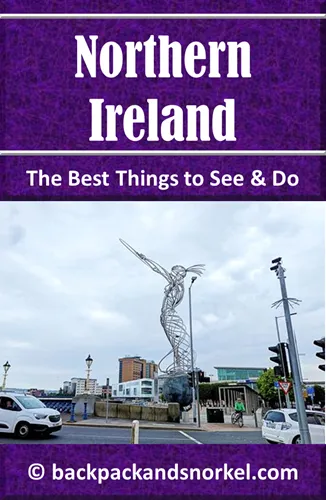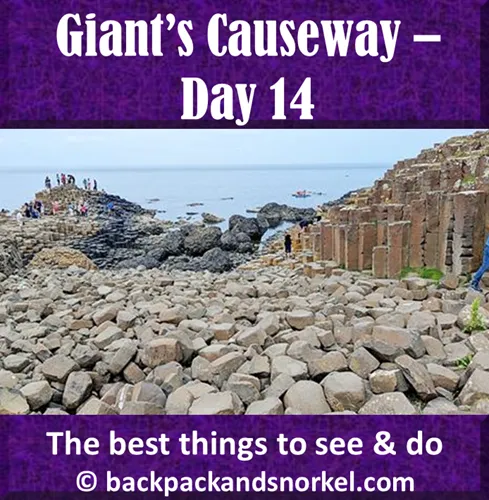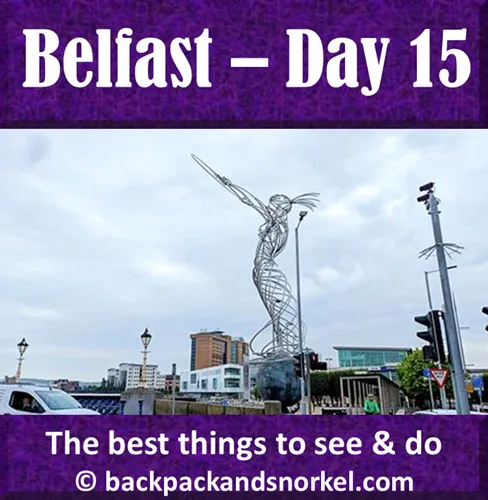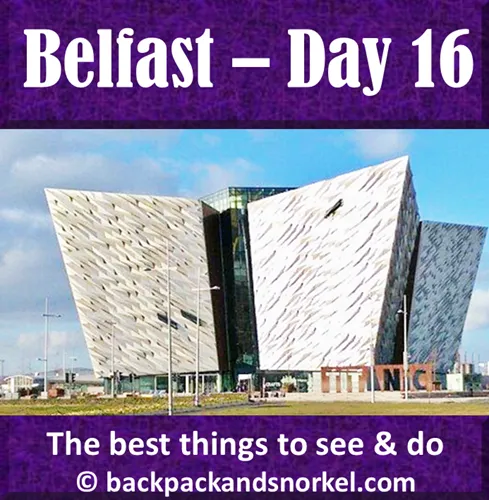Backpack and Snorkel Travel Guide for Giant’s Causeway, Dunluce Castle, Bushmills Distillery, Carrick-a-Rede Rope Bridge, and Dark Hedges - Northern Ireland Purple Travel Guide
Today we will visit some of the highhlights in Northern Ireland: Giant’s Causeway, Dunluce Castle, Bushmills Distillery, Carrick-a-Rede Rope Bridge, and Dark Hedges. We provide detailed information and the best things to see and we show lots of photos so you know what you can expect.
Today we will see one of the major highlights of Northern Ireland: Giant’s Causeway.
Afterwards, we will pay short visits to Dunluce Castle, and Bushmills Distillery, and then visit two very instagrammable sites: the Carrick-a-Rede Rope Bridge, and the Dark Hedges that you may remember from Games of Thrones.
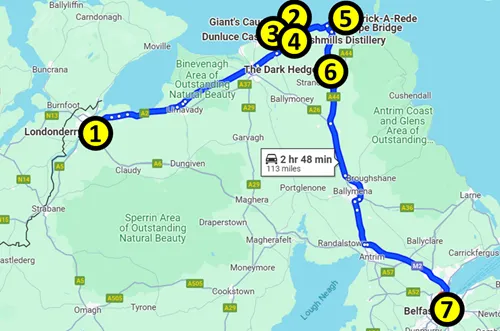
1 = Derry
2 = Giant’s Causeway
3 = Dunluce Castle
4 = Bushmills Distillery
5 = Carrick-a-Rede Rope Bridge
6 = Dark Hedges
7 = Belfast
Here at Backpack and Snorkel Travel Guides, we typically promote self-guided walking tours.
But we realize that not everybody likes to walk by themselves in a foreign city. So, just in case that you rather go with ab guide: NO PROBLEM! Please see the tours below.
Giant’s Causeway
Giant's Causeway consists of about 40,000 interlocking basalt columns, which are the result of an ancient volcanic fissure eruption from 50 to 60 million years ago, where lava flowed through a long volcanic fissure forming a huge lava field that reached from Ireland to Scotland.
When the lava cooled, it contracted vertically into hexagonal columns to relieve stress. Further cooling led to horizontal fractures (biscuits). In many cases, the horizontal fracture resulted in the upper part having a concave shape, while the bottom part’s surface had a convex shape. Those are called Ball and Socket joints.
The size of the columns is dependent on the speed at which the lava cooled.
Irish legend has its own explanation:
Irish giant Fionn mac Cumhaill (Finn MacCool) was a giant who was brave and kind, but he liked to brag that he was the tallest and strongest. Across the ocean in Scotland, there lived a mean giant called Benandonner.
Benandonner heard of Fionn’s bragging and both got in a shouting match across the sea, and the result was that both agreed to a fight.
To get to each other, they started building a causeway from each side by taking rocks and throwing them into the sea.
After a hard day’s work building the causeway, Fionn’s was exhausted and he got more and more scared, as Benandonner got bigger and bigger the closer they came to each other. And he realized that he would not stand a chance as Benandonner was much bigger than he was.
Fionn ran home to his wife and told her that he’s in big trouble. Luckily, Fionn's wife Sadhbh was very smart. She told him to disguise himself as a baby and then she tucked him in a cradle in the living room of their house.
The next day, Benandonner finished building the causeway and he ran straight to Fionn’s house and banged on the door.
Sadhbh told him that Fionn was out, but would come back later.
In a video they show at the visitor center, Sadhbh plays several tricks on Benandonner and always told him that Fionn did things better and faster. This may, however, be the museum’s legend.
Anyway, Benandonner searches the house and finds the baby. Sadhbh told him that this was their son. Judging by the size of the baby, Benandonner thinks that its father, Fionn, must be much bigger than he is.
Scared for his life, he flees back to Scotland and tears the causeway up behind him.
And as the story goes: Fionn and Sadhbh lived happily ever after.
By the way, across the sea in Scotland, there are identical basalt columns at Fingal's Cave on the Scottish isle of Staffa.
At the time of writing, Giant’s Causeway is open dusk to dawn, while the visitor center and parking lot are open from 9am – 5pm (March to November).
Admission is £15.50 per adult, children pay half.
It is important to note that the tickets give you a 30min window to enter. So, make sure that you don’t arrive late, as you could be refused admission.
The ticket includes parking, access to the visitor center with its small museum and restrooms, and a guided tour.
There is no need to take the guided tour, but we recommend it as we found it very interesting.
From the visitor center, you will need to walk downhill for 0.75 miles (1.2 km) to the basalt columns, or you can take the shuttle bus for £1 per person per one way trip.

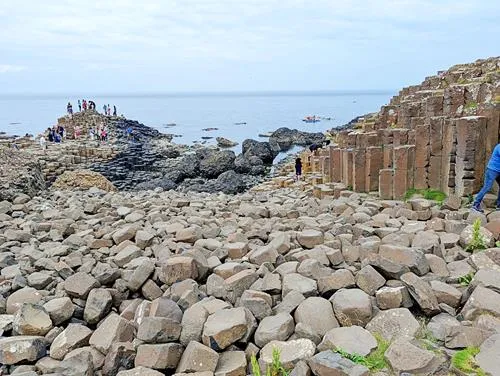
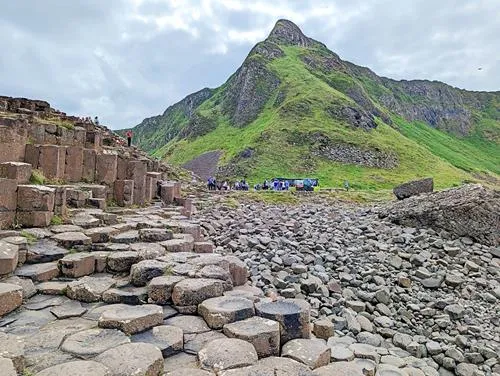
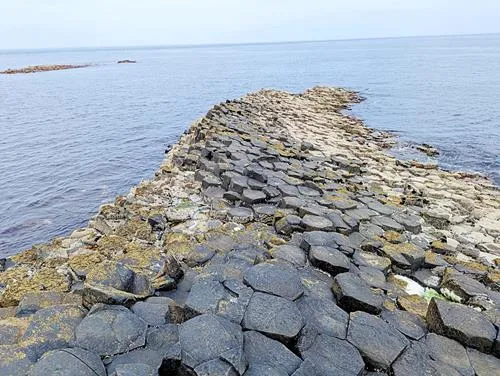
Dunluce Castle
Dunluce Castle was built in the 13th century.
In 1588, a ship of the Spanish Armada was caught in a storm, wrecked, and sank on the rocks near the castle. The ship’s cannons were installed in the castle, and the ship’s cargo was sold and the proceedings used to restore the castle.
A local legend says that at some point in the past, part of the cliff collapsed, taking a part of the castle’s kitchen with it and only a kitchen boy survived, because he was sitting in the part of the kitchen that did not collapse. Afterwards, the owner’s wife refused to live in the castle any longer.
This legend cannot be true because the kitchen is still fully intact. What did happen, though, is that the north wall of the residence building collapsed into the ocean in the 18th century.
Before you get to the bridge that crosses the deep cliffs and takes you to the castle, there used to be the town of Dunluce. It was, however, razed during the Irish uprising of 1641.
It is speculated that the town, which was started in 1608, may have had some of the most modern houses in Europe. That included indoor toilets, which were just beginning to be introduced in Europe, and a grid-based street network. 95% of the town of Dunluce is still unearthed.
You can either visit the castle by paying admission, or you can walk downhill into the canyon and watch the castle high above you. Just beware it is a steep way down on a well-maintained path.
The castle itself is in ruins – there is no roof, and no furniture. Just walls.
At the time of writing, opening hours are:
- February - November: 9:30am - 5pm
- December - January: 9.30am - 4pm
Admission is £6.00 per adult.
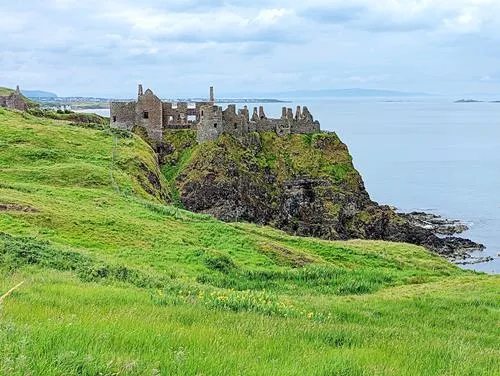

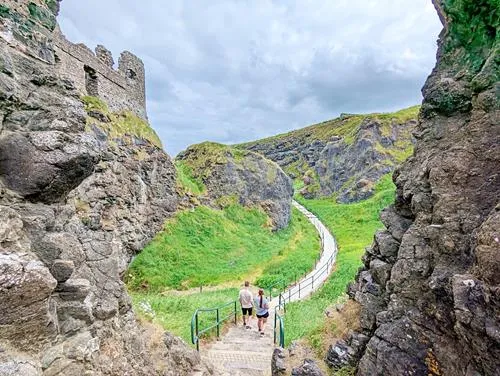
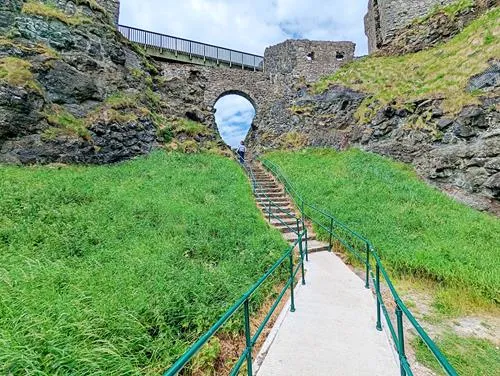
Bushmills Distillery
The Old Bushmills Distillery was founded in 1784. It produces the Bushmills brand of Irish whiskey and is welcomes about 120,000 visitors per year.
The original distillery had a rough start and it seems that it was closed more years than it was actually operating. But things changed when it was acquired in 1860.
The company was successful and even a devastating fire in 1885 that destroyed the original Bushmills buildings did not have a lasting impact. Only five years later, in 1890, the steamship SS Bushmills that was owned and operated by the distillery, made its maiden voyage across the Atlantic to deliver Bushmills whiskey to the USA. It called on ports in Philadelphia, and New York City, and then Singapore, Hong Kong, Shanghai, and Yokohama.
In the 20th century, the USA became a very important export market for Bushmills and prohibition in 1920 in the US hit the company hard. Sensing that prohibition was coming to an end in 1933, they stockpiled large amounts of whiskey that they sold in the US after prohibition was lifted.
After WWII, the company changed owners a couple of times. Since 2014, it is owned by Proximo Spirits.
At the time of writing, Bushmills Distillery is open:
Mon – Sat: 10am - 4:45pm
Sun: 11am - 4:45pm
Distillery tours are offered throughout the day and last between 1h and 2.5h and they cost between £15 and £50 per adult.
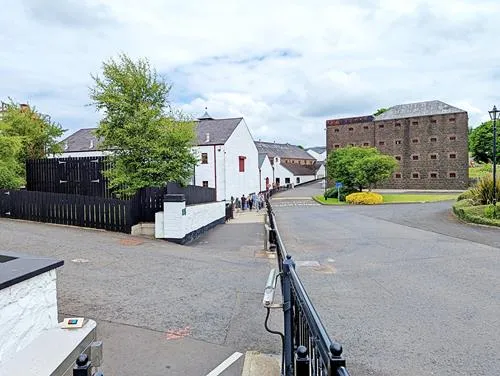
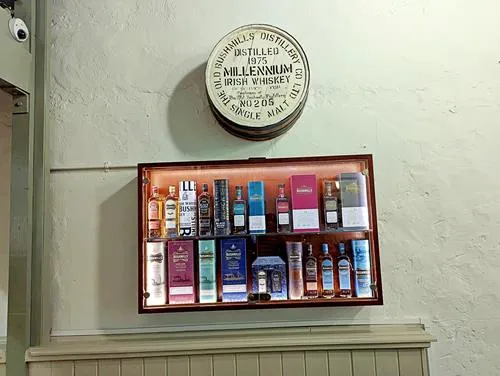
Carrick-a-Rede Rope Bridge
The Carrick-a-Rede Rope Bridge is one of those instagrammable places in Northern Ireland that has catapulted the visitor numbers to 400,000-500,000 people per year. Nowadays, they even charge for parking.
The Carrick-a-Rede Rope Bridge was only built for tourists so that they can experience walking over a rope bridge that spans from the mainland to a small island over deep cliffs with ocean water below. The bridge is 66 ft (20 m) long and 98 ft (30 m) above the water. Since there can be strong winds in this area, the bridge closes, sometimes on short notice, when it gets too dangerous to cross.
Local salmon fishermen had built bridges to the island for over 350 years, as this area was a popular route of the salmon to their spawning grounds from June until September. Unfortunately, there are now very few salmon left, so salmon fishing has stopped.
At the time of writing, the rope bridge is open from Feb through Nov, typically from 9am – 4:30pm.
The admission ticket which includes bridge crossing and parking is £13.50 per adult, while parking-only is £10 per car.
To get to the rope bridge, you will need to follow a 0.7-mile (1.1 km) trail from the parking lot along the cliffs. The trail is open for people that only paid for parking, too, and it has beautiful scenic views.
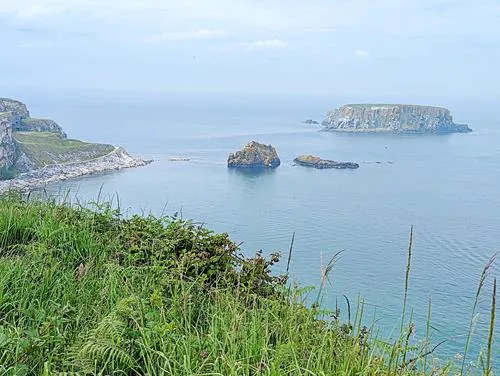
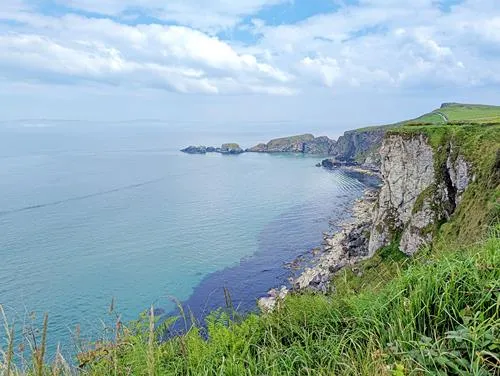
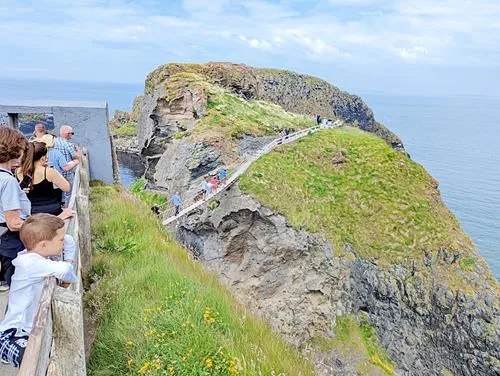

Dark Hedges
Dark Hedges is another instagrammable location in Northern Ireland.
Popularized as the filming location for King's Road in Game of Thrones, and the 2017 Transformers movie The Last Knight, this site sees lots of visitors. Admission is free, but you will be directed to a paid parking lot from which you follow the masses to Dark Hedges on Bregagh Road between Ballinlea Road and Ballykenver Road.
The road itself is closed to vehicular traffic.
Due their age and vandalism, only a bit more than half of the originally more than 150 beech trees are still standing and some are so damaged that they will likely be felled in the new future.
The original beech trees were planted at around 1775, when a mansion called Gracehill House – named after the owner’s wife – was built and the trees were planted to create an imposing road to the estate.

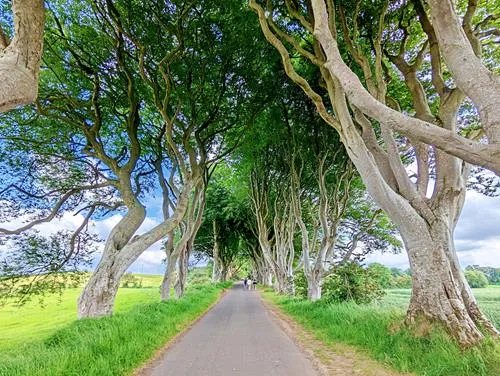
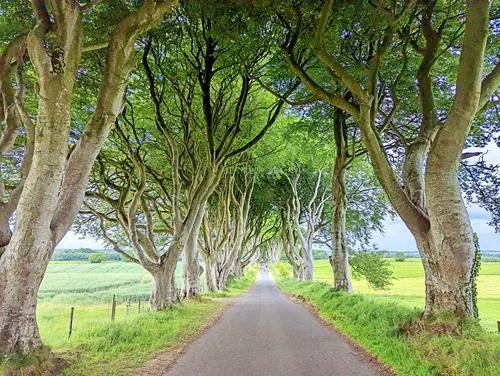
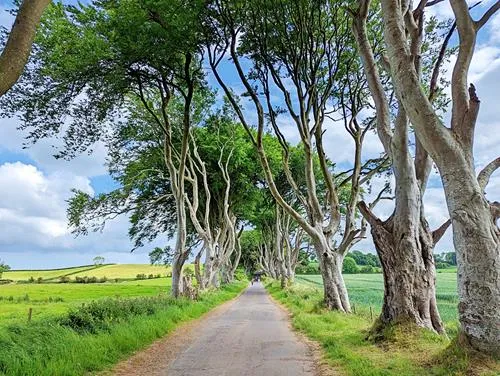
Where to stay in Belfast
Belfast is the capital city of Northern Ireland, and its largest city with a population of 345,000 people, and a metropolitan area population of 672,000.
The city was the hardest hit area during The Troubles. The 21st century has been good for Belfast. Through special agreements, Belfast is the only region in the world that is able to trade goods freely with both GB and EU markets. And tourism is booming.
Here is the accommodation that is available when you visit:
Holiday Inn Belfast (book)
We chose the Holiday Inn Belfast for its excellent location, and competitive price and quality. It is centrally located and within walking distance of the destinations for tomorrow’s self-guided walking tour of Belfast.
Other than that, it is a fairly typical Holiday Inn. The rooms are clean and comfortable but the breakfast buffet was much better than what you normally get in Holiday Inns.
The staff was real nice and helpful, too.
There is no parking lot next to the hotel, but upon check-in you will get a voucher for free parking at the parking garage at the Great Victoria Street train station.
Access is right north of the hotel through St Andrews Square E.



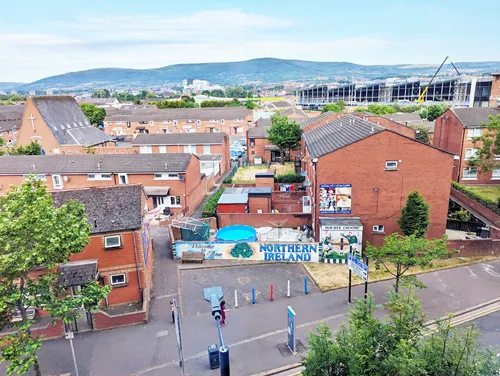
Where do you want to go now?
Author: Rudy at Backpack and Snorkel
Bio: Owner of Backpack and Snorkel Travel Guides. We create in-depth guides to help you plan unforgettable vacations around the world.
Other popular Purple Travel Guides you may be interested in:
Like this Backpack and Snorkel Purple Travel Guide? Pin these for later:


